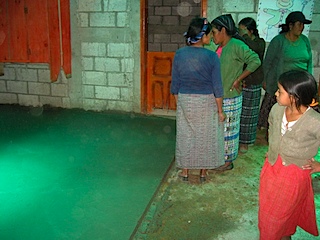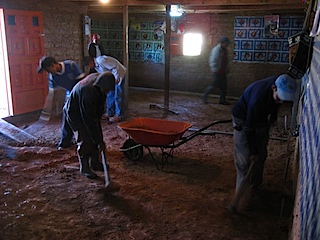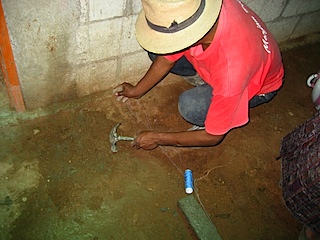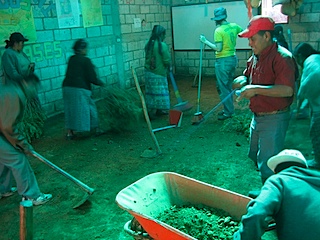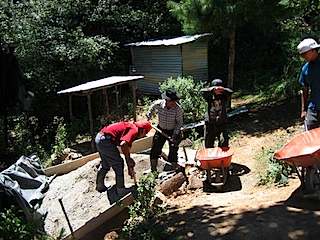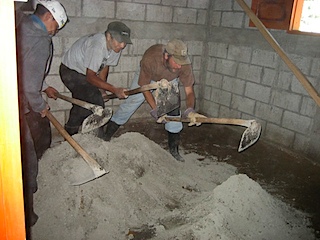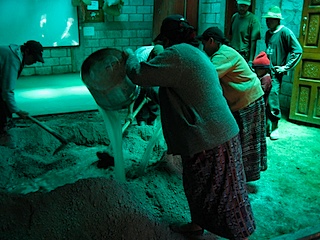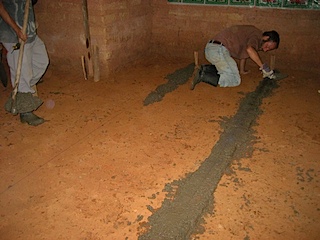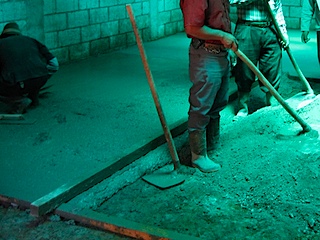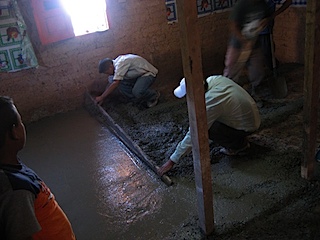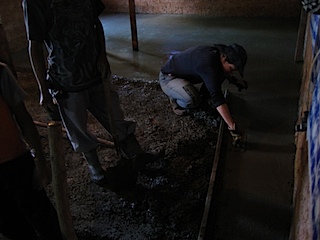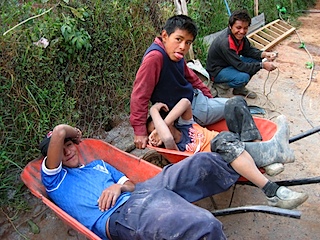This week we started construction on our SPA project. It’s a relief to finally be BUILDING something after so many months of meetings, paperwork, and waiting. To accommodate the differing needs of the villagers, we’ll be helping the 30 participating families build four different technologies: concrete floors, water tanks, improved stoves, and sanitary latrines. We decided to start with floors, because they are the simplest of the four; a chance to work out the bugs, get people used to how we do business, and build faith in our abilities. We had six families stick with the floor project, and the village leaders laid out a pretty aggressive schedule: a floor each day, totaling 240 square meters (about 2500 square feet) in a week. On the seventh day, we rest.
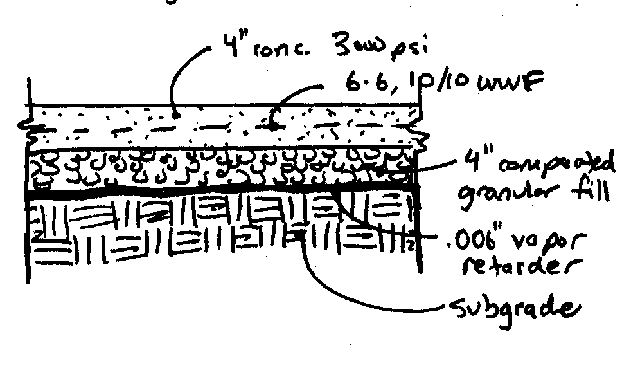 Why a concrete floor? Well, most of the houses in the area have dirt floors. Guatemala is host to lots of germs, microbes, and parasites that are passed through dirt: when toddlers eat it as they’re playing, when people walk on it with bare feet, even when they sweep the floor and the dust settles onto their tables and eating utensils. But “concrete floors” here aren’t quite like the ones we build in the US, and I have to lower my standards as an architect. For a concrete floor in the US, I’d lay down a 6 mil vapor retarder, then 4″ of crushed gravel, run a vibratory compacter over it, roll out welded wire fabric for reinforcement, then pour 4″ of concrete. I’d use a laser level to get it flat, and finish it with a steel bull float.
Why a concrete floor? Well, most of the houses in the area have dirt floors. Guatemala is host to lots of germs, microbes, and parasites that are passed through dirt: when toddlers eat it as they’re playing, when people walk on it with bare feet, even when they sweep the floor and the dust settles onto their tables and eating utensils. But “concrete floors” here aren’t quite like the ones we build in the US, and I have to lower my standards as an architect. For a concrete floor in the US, I’d lay down a 6 mil vapor retarder, then 4″ of crushed gravel, run a vibratory compacter over it, roll out welded wire fabric for reinforcement, then pour 4″ of concrete. I’d use a laser level to get it flat, and finish it with a steel bull float.
Here, though, that would be prohibitively expensive and total overkill. Vapor retarder? Most of the moisture is going to get in through the holes in the roof or the adobe walls. Compacted gravel? The clay of the floor is already hard as a rock from years of people walking on it. Wire reinforcing? People that own one set of clothing, cook over a campfire, and bathe once a week don’t care if they have hairline cracks in their floor. And that 4″ of concrete becomes 2″; we’re not parking cars on it, and cutting the depth in half cuts the project cost in half (meaning we can reach twice as many families).
Now, for your enjoyment, I will walk you through how you build a concrete floor, Guatemala-style.
There you go! I must say, it all works pretty well, and the people are really excited that they can do this themselves. At the start of the day, I am usually doing a lot, but as people get over their fear of something new and try their hands at the various jobs, I can usually step back, and by the end they’re doing everything. A few people have really taken to the work; Juárez (who has also helped us by translating health talks once in a while) can now finish concrete better than I can.
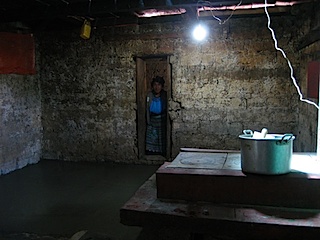 After the first floor, I had a meeting with Diego and Ximon, the two leaders I’m working with. They’ve done a great job, and are surprisingly proactive. For example, I gave them the list of materials we needed when we went on our trip to the south, and when I returned, everything was in place: they ordered through the hardware store, rode along with the driver to show them which houses to drop the materials at, and organized the villagers to carry everything to where it needed to be. But there was a problem: they were worried we’d been shorted materials.
After the first floor, I had a meeting with Diego and Ximon, the two leaders I’m working with. They’ve done a great job, and are surprisingly proactive. For example, I gave them the list of materials we needed when we went on our trip to the south, and when I returned, everything was in place: they ordered through the hardware store, rode along with the driver to show them which houses to drop the materials at, and organized the villagers to carry everything to where it needed to be. But there was a problem: they were worried we’d been shorted materials.
“When they unloaded the gravel, they said that it was 15 shovelfulls to a wheelbarrow. But it’s supposed to be 20,” Ximon said. He went on to explain that if they were unloading 15 shovelfulls from the truck and calling it a wheelbarrow, we were going to be 25% short on our materials.
This is one of the challenges of building in the third-world: measurements. Yeah, I can do metric. I worked on some federal projects, and studied architecture in Europe. But here, they measure in barras (a bit less than a yard; lumber is measured in barras), quintales (100 pounds; rebar is ordered by the quintal), cuerdas, and other medieval anthropomorphic measures. When you ask for so many cubic yards (or cubic meters) of gravel, you get blank stares. They measure it in wheelbarrows, and for larger quantities, in truckloads. Thankfully, there are only three sizes of wheelbarrows in Guatemala, and they are regional. Around here, 15 wheelbarrows makes a cubic meter.
“Well, we paid for wheelbarrows,” I replied. “I don’t care if he uses a big shovel and 15 will fill one, or if he dishes it out with a spoon and it takes 200. If we don’t have the wheelbarrows we ordered, we aren’t going to pay him.”
They seemed pretty pleased with that; sometimes it’s nice to know that we’re all on the same side. They explained that the building materials guy wouldn’t even discuss the issue with them, since I was the one who first contacted him. “Well, we will go talk to him together. He needs to know that you two are running this; I’m just the advisor.” I chuckled. “And you guys have the checkbook, so he’d better get over it pretty fast.”
The next floor we did called for 50 wheelbarrows, so we were extra careful to measure exactly the materials we’d been sent. To everyone’s surprise, there were 50 and a half! This gets back to the Mayan paranoia of being cheated, of not getting your fair share. Every day as we work, we hear comments like “um, we’re not going to have enough materials”. What’s the big deal? If we come up short, we’ll just grab a few wheelbarrows from the next house, and order some more to replace it at the end of the project… and that’s exactly what we did when we needed two extra sacks of cement on one of the houses. But I guess if you’re as poor as they are, you don’t think that way. What’s funnier is that Math Doesn’t Lie. I worked out the quantities pretty carefully, and so far, we’ve been dead on except for a case where they overdug the floor when they were leveling, and we had to use more concerete in one spot that we’d planned on.
In the first house we did, Juárez kept saying, “Man, I think we need more gravel. This isn’t enough. How many? Three of four wheelbarrows, I think. Yeah, we need more.”
I just kept shaking my head. “No, I think we’re good. This room called for 12 wheelbarrows. We’ve only used 8 so far.” Half an hour and four wheelbarrows later, we were leaning through the doorway to trowel the last piece. “So, how many more wheelbarrows do you think we need now?” I asked, winking. He laughed.
After this week, we might have one more floor to do. With the support of the Rotary Club of Logansport (Indiana), we put in a floor in the one-room schoolhouse. I am going to ask them if they are also interested in sponsoring a floor in the village meeting hall. It’s about the same size as the school (60 square meters), and it’s really dusty and dirty in there during the dry season. It’s a good, worthy project and we’re already in the groove for floors. But I’m making this my ace in the hole. Diego, one of the two village leaders, is really excited about it and has made the meeting hall floor his pet project.
“If you help me, I’ll help you,” I told him a few days go. “You have done a fantastic job of bringing the people together and keeping on schedule. But to be honest, I’m a little worried. We have to be done with this project by the end of June, paperwork and everything, or else Emily and I are going to be in big trouble with our boss.” That last bit was a half-truth; the “big trouble” is that we would have to stay in Guatemala an extra month to finish the project, something we want to avoid. “So I’ll make you this deal: if you keep the project on schedule, when we are done with ALL the other construction, we will show up and build the floor in the meeting hall. You won’t even have to pay the 30%; we’ll cover all the materials. It will be the grand finale, a thank you for all the work you’ve done to make this project happen.”
He seemed pretty excited about it, and agreed wholeheartedly. When I got back from the meeting, I was a little scared to tell Emily about the “insurance” deal I’d made, since we don’t yet have the support of Rotary. But I see it this way: if Rotary isn’t interested, I’d fund that floor with $300 out of my own pocket if it would mean that I’m home with my friends and family come August 1.
Lets hope the other three project types go as smoothly as the floors.
*you need as many wheelbarrows of gravel as you have square meters, times .8. You need half as many sacks of cement as you have wheelbarrows of gravel.
